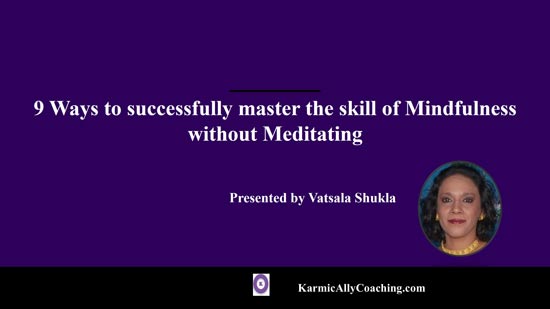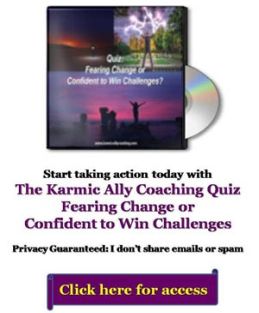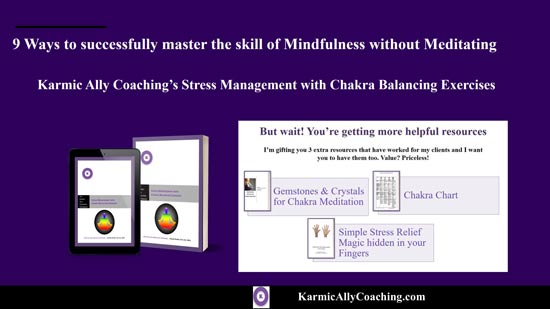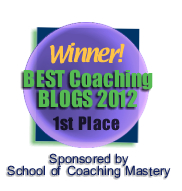This post has already been read 853 times!

Practicing mindfulness benefits the practitioner both in their personal and professional life and especially when they are trying to demonstrate their leadership ability.
I’ve had professionals tell me about the free trainings in their company for learning mindfulness meditation so I know it’s quite popular.
But do you understand what is meant by mindfulness?
I have my own version of mindfulness in the blog post meditation for mindful leadership but there is a simpler one for the purposes of this post which I found on Mindful.Org.
“Mindfulness is the basic human ability to be fully present, aware of where we are and what we’re doing, and not overly reactive or overwhelmed by what’s going on around us.
Mindfulness is a quality that every human being already possesses, it’s not something you have to conjure up, you just have to learn how to access it.”
Prefer to read? Here’s the Video Transcript
Mindfulness Meditation is a well-known technique of meditation and one which is used by many leaders. But have you ever wondered how you could actually successfully master this skill of mindfulness without meditating?
Hi, I’m Vatsala Shukla, Chief Encouragement Officer of Karmic Ally Coaching and in this video, I’m going to actually show you how you can do it if you are not keen on meditation.
But first, just so that we are all on the same page, what’s mindfulness meditation?
The way I’d like to describe it is that it is the combination of meditation with the practice of mindfulness where we’re focusing on the present, we’re acknowledging and accepting our thoughts, feelings and sensations from a place of non-judgment.
Now that we’ve got this definition out of the way, let’s address the question that I had started with.
And that is, what if meditation isn’t your cup of tea or coffee?
Meditation doesn’t suit everyone and while meditation may be the most effective way to achieve mindfulness, there are other options that you can try because in my experience, there are people who have difficulty practicing traditional seated contemplation.
Or they find it challenging to sit in meditation for long periods of time. Their feet may fall asleep or they may have a back problem and they find that difficult or it’s in your nature and temperament that you’re seeking a shorter version which has more active participation from the other senses.
Now if any of that sounds familiar to you or sounds like you, then I’ve got some good news for you today. You can still find more happiness and peace of mind through a variety of physical and mental practices.
And I’m going to be sharing 9 of them. In fact you may find that these activities are beneficial on their own or they may strengthen your ability and interest in meditating.
But whatever path you follow, do try one or all of these 9 ideas for becoming fully present.
Physical Practices to improve mindfulness
So the first one is breathe deeply.
Engaging with your breath is a practice that you can do anywhere. And here what you’re going to do is you’re going to pay attention to each inhalation and each exhalation.
You’re going to feel calmer and stronger. And remember, at least in this one, to sit with a straight back in order to get the full benefit.
To allow inhalations and exhalations to fill up your lungs and empty it out. And when you do that you do become more aware of what’s going on around you.
In fact I’ve got a blog post which can show you how to do this, even better as well as provide you with more stimuli, external stimuli in order to engage you in it.
The next one is a very simple one and many of you would be aware of it and that is to do yoga. Because yoga connects your mind, body, and breath.
And as a bonus, if you do the down dog and other poses that will open up your hips you would be able to sit more comfortably if you do decide to meditate later sitting down.
The third one, which I don’t think you actually expected me to say is to do creative flower arrangements.
Now this actually does engage your mind because you know you’re observing the flowers, you’re thinking about how to present them.
And one of my favorites is Ikebana which was originally used to create shrine offerings, but you can use it to connect with nature and as a tool of self-expression.
In fact I recommend that you either take a live class or an online class if that is not possible or even pick up a book at the library to learn about the various techniques.
I actually studied the Ohara school of Ikebana when I was still in school. I was participating in the Duke of Edinburgh Award Scheme and the hobby I had to take up was Ikebana.
And I can tell you that even to this day doing creative flower arrangements does make me more aware of nature and of what I’m actually doing. And it is a must try.
Then the next one is to learn martial arts and you know, Karate and other martial arts involves a lot more than just fighting.
Regardless of what you’ve seen in the movies, building your character is more important than just chopping of blocks of wood by hand.
So, you try to remember Enter the Dragon with Bruce Lee in it and you’d notice he was doing a lot more in it than Kung Fu and just hitting people. Or remember the Karate Kid movie where it all comes down to developing that mindset and the child becoming, the little hero, becoming more aware of what he was doing and the confidence that it brought. So this is not to be laughed at or put aside.
And the fifth one is one that I’m sure you’re going to love and that is to drink tea.
And make it even better than just, you know, glugging down a mug of Tea but to actually hold a tea ceremony which is another tradition to encourage mindfulness.
And if you’re doing this at home, then try giving your full attention to any food or drink that you’re having. Savor that cup of tea or even coffee for that matter, smell the aroma, feel the warmth in your hand, enjoy the taste.
And the same thing goes for the food. In fact when His Holiness the Dalai Lama tells us to do mindful eating and to chew our food 16 times before swallowing it down, it’s not that he’s teaching you how to chew food but by doing that ritual, you’re actually getting a full sense of what you’re eating.
You’re mindful of what you’re putting in your mouth. You’re getting the taste, the aroma and the textures as you chew and swallow.
Okay, so these were 5 ways that you can actually develop the skill of mindfulness without even a bit of meditation but what about some inner or mental practices.
I’ve got 4 for you.
Mental or Inner Mindfulness Practices
The first one is to slow down. Now you might remember the saying that you know, you have to slow down in order to go fast.
What this basically means is, that you know, slow down, do deliberate movements, think before you move. Consider each step that you’re taking and that way when you slow down, you do become more mindful because you know what you’re doing.
The second one is Focus and by focus what we mean is give your attention completely to what you’re doing, to the task at hand.
Now in a home setting what it means is that when you do sit down to mealtime, please put your mobile phone on silent mode, ask everybody to in fact to put it on silent mode, enjoy the food, observe your family, talk to them.
Focus on them and give them the quality time that they need. When it comes to doing a piece of work, even though everybody loves to say that they are multi-taskers, you don’t really get much done.
In this case, become a mono-tasker. Put your attention on a particular task at hand, complete it and then move on to the next.
Or if there’s a case where you need to do a couple of tasks at the same time which are slightly different at the same time, then put a timer for say 15-20 minutes or for however long it’s going to take for each task and during that time, just focus on that particular task.
The third practice that you can use in order to master the skill of mindfulness is to simply let go of judgments. And here what I mean is, you know, don’t always judge others. Don’t judge yourself. Try to keep a clean perception of things.
Don’t add to a situation or put in an interpretation. You may be right, you may be wrong. But the point is this, that a mindful person actually observes what is and then accepts the reality. They don’t start judging or putting or looking at a situation with rose colored lenses.
And then, the last one is, to live in the present. What it means is that stop living in the past, stop every time something good is happening to you in the present, stop thinking about what happened in the past.
Stop trying to think of what’s going to happen in the future. Don’t start future pacing thinking oh my God, I’ve done this now something’s going to go wrong or something ‘this will happen, something that will happen’.
It doesn’t work like that. Live in the present, enjoy the moment. If you’re out in the garden, just look up at the sky, enjoy that clear blue sky. You see a bird on a branch, enjoy that. Live in the present.
And if you’re in the company of people, be with them, be with them in the moment. You’re with your little dog wants to play, play with that dog. It will help you to develop your skill of mindfulness and to become more aware of things that might miss you otherwise.
And that is something that I myself had discovered during the lockdown last year when Miss Coco and I used to go to the garden in the afternoons. Now we were doing Nature Walking Meditation. I’ll share a link to that practice with you.
But when the two of us used to be sitting in the garden and the whole world was in lockdown we were actually able to hear the chirping of the birds. We actually noticed a couple of squirrels playing tag near us. We used to enjoy the breeze.
We were present in the moment and those are memories that are priceless. I cannot even articulate and tell you how good those memories were. But we enjoyed our moment of mindfulness and it was a kind of meditation.
So, now that I’ve shared the 9 ways that you can actually master the skill of mindfulness without meditating, what about if you suddenly decide, that Vatsala, I would like to meditate but how do I make it easier?
How to make Meditation easier
Now here are my 3 tips for you, especially if you’re a beginner.
The first is keep it brief.
You don’t have to sit for 20 minutes doing Transcendental Meditation or 20-15 minutes or half an hour doing any kind of meditation. Keep it brief and then build it up.
Sometimes just sitting quietly for a minute or 2 minutes, you know, in your self, ignoring the outside world and just listening to your own mind, that helps you to build up the concept of, practice of meditation.
And as you feel more confident and don’t get distracted, build it up to longer periods of time.
The other way that I would suggest is to walk and stretch.
Now not all meditation involves sitting with your fingers in different mudras poses and your chanting away. Now I had already mentioned the Nature Walking Meditation to you.
Sometimes simply walking is a form of meditation. The thing is that then focus on the walking. Be aware of the movement or even if you’re in the house pottering about, just engross yourself in that activity. That too is a form of meditation.
Doing gardening is a form of meditation. What is more required is that you’re completely focused on the object on which you’re working and to the exclusion of all others.
Need more ideas? Read this post on exercising for health here.
And then also manage stress.
Now there are various ways that you can try to manage stress. Normally you might find that if you do sit down to meditate, that instead of reaching the stillness of the mind, all sorts of crazy thoughts start to come out.
And this is going to happen because as you go deeper, things that are buried in your subconsciousness are going to start floating above. And what I suggest is, acknowledge the thing and let it go.
Don’t distract yourself by starting to think about what is and what isn’t and what you have to do. At that moment just focus on going deeper and acknowledge it, whatever issue is coming up and let it go for the time being and you can always deal with it later.
And if you want more exercises to help you build up your mindfulness practice, then I offer you Karmic Ally Coaching’s Stress Management with Chakra Balancing Exercises.
A link is given below in which I’m going to show you different exercises that you can do for each Chakra.
There are also some meditations which do not require you to meditate with the mindfulness meditation and I have these one minute tools that help you to manage your stress which in themselves become mini meditations.
And of course they help you build up your mindfulness. And along with that, there are 3 bonuses. There’s the Chakra Chart, in case you’re really interested in pursuing more information about Chakras.
I also have a little ebook with the gemstones and crystals for chakra meditation and also simple stress relief magic which is hidden in your fingers.
And that will also help you with mindfulness though it doesn’t require you to sit down and meditate.
So my final words to you are that you don’t really have to miss out on the benefits of mindfulness just because you’re uncomfortable sitting for long periods or troubled by disturbing thoughts.
It all comes down to developing your ability to focus and absorb what’s going on around you from a heightened sense of awareness to improve clarity and your decision making skills.
And now, I have a question for you and I would love to have you answer it in the comments.
The question is, which method will you try first? Will it be one or will you give all of them a shot and see which one works for you. Let me know. So that’s all from me.
This is Vatsala Shukla from Karmic Ally Coaching signing off. See you next time. Bye for now.




 I adhere to the Certified Coaches Alliance Code of Ethics and Standards. A copy is available on request.
I adhere to the Certified Coaches Alliance Code of Ethics and Standards. A copy is available on request.
 Let's Talk through the Connect Form:
Let's Talk through the Connect Form: